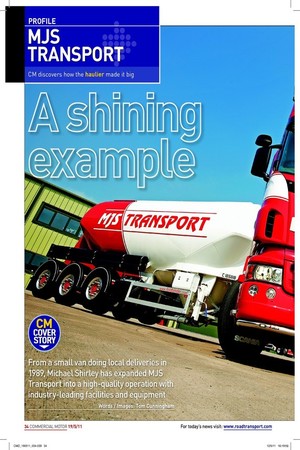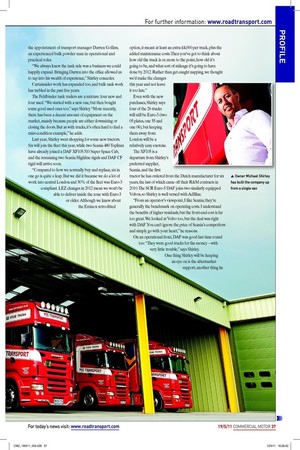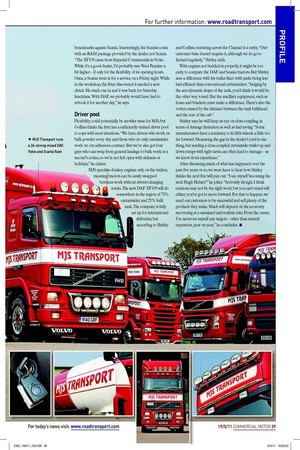From a small van doing local deliveries in 1989, Michael
Page 23

Page 24

Page 26

Page 28

If you've noticed an error in this article please click here to report it so we can fix it.
Shirley has expanded MJS Transport into a high-quality operation with industry-leading facilities and equipment Words / Images: Tom Cunningham “Michael is a good bloke to work for, but he’s fastidious about image and cleanliness,” one employee told us as he wondered past. And he’s right – there’s no deeply ingrained dirt to be found anywhere. It’s a coincidence that this is also the weekend of the first Truckfest gathering. “We’re not going to Peterborough this year, but these trucks look like this every day of the year, not just a week before a show or event,” Michael Shirley tells us.
From its base in rural Staffordshire, the firm operates 26 trucks and 21 trailers, eight of which are bulk powder tankers. It also runs three rigid 8x4 tanks, which, Shirley says, is down to site access issues. The remainder is made up of curtainsiders, which MJS has in artic and rigid forms. The current line-up comprises seven Volvos, eight DAFs and 11 Scanias.
The yard is as equally impressive as the kit, with a clean concrete hardstanding, a 358-pallet space warehouse and a fully equipped two-bay workshop, which employs three fitters – one full-time and two part-time. The last remaining remnants of the old yard, a brick-built shed, is due to be demolished to make way for a new fuel island.
Back in the office, Shirley explains the reasons behind his insistence on presentation. “The image of the trucks and the premises has to play a part with some clients, maybe more so the blue-chip people. But the bit we concentrate on even more is the hidden aspect, the bits people don’t see. Customer service is our number-one priority.” Shirley says the business is heavily geared towards looking after its existing client base. “If you develop a reputation for keeping your existing client base happy, business expansion will follow as a natural progression,” he believes.
For much of its trading period, MJS markets itself as a general haulier with a mixed curtain fleet, but a move into the niche sector of bulk powder tanks has seen a healthy, three-fold rise in traffic volumes. The gains coincided with the appointment of transport manager Darren Gollins, an experienced bulk powder man in operational and practical roles.
“We always knew the tank side was a business we could happily expand. Bringing Darren into the office allowed us to tap into his wealth of experience,” Shirley concedes.
Curtainsider work has expanded too, and bulk tank work has trebled in the past five years.
The Feldbinder tank trailers are a mixture: four new and four used. “We started with a new one, but then bought some good used ones too,” says Shirley. “More recently, there has been a decent amount of equipment on the market, mainly because people are either downsizing or closing the doors. But as with trucks, it’s often hard to find a mint-condition example,” he adds.
Last year, Shirley went shopping for some new tractors. Six will join the fleet this year, while two Scania 480 Toplines have already joined a DAF XF105.510 Super Space Cab, and the remaining two Scania Highline rigids and DAF CF rigid will arrive soon.
“Compared to how we normally buy and replace, six in one go is quite a leap. But we did it because we do a lot of work into central London and 30% of the fleet was Euro-3 compliant. LEZ changes in 2012 mean we won’t be able to deliver inside the zone with Euro-3 or older. Although we knew about the Eminox retro-fitted option, it meant at least an extra £4,000 per truck, plus the added maintenance costs. Then you’ve got to think about how old the truck is or, more to the point, how old it’s going to be, and what sort of mileage it’s going to have done by 2012. Rather than get caught napping, we thought we’d make the changes this year and not leave it too late.” Even with the new purchases, Shirley says four of the 26 trucks will still be Euro-3 (two 05 plates, one 55 and one 06), but keeping them away from London will be a relatively easy exercise.
The XF105 is a departure from Shirley’s preferred supplier, Scania, and the first tractor he has ordered from the Dutch manufacturer for six years, the last of which came off their R&M contracts in 2010. The SCR Euro-5 DAF joins two similarly equipped Volvos, so Shirley is well versed with AdBlue.
“From an operator’s viewpoint, I like Scania; they’re generally the benchmark on operating costs. I understand the benefits of higher residuals, but the front-end cost is far too great. We looked at Volvo too, but the deal was right with DAF. You can’t ignore the price of Scania’s competitors and simply go with your heart,” he reasons.
On an operational front, DAF was good last time round too. “They were good trucks for the money – with very little trouble,” says Shirley.
One thing Shirley will be keeping an eye on is the aftermarket support, another thing he benchmarks against Scania. Interestingly, the Scanias come with an R&M package provided by the dealer, not Scania. “The XF105 came from Imperial Commercials in Stoke. While it’s a good dealer, I’d probably rate West Pennine a bit higher – if only for the flexibility of its opening hours. Once, a Scania went in for a service on a Friday night. While in the workshop, the fitter discovered it needed a new clutch. He stuck one in and it was back for Saturday lunchtime. With DAF, we probably would have had to rebook it for another day,” he says.
Driver pool
Flexibility could potentially be another issue for MJS, but Gollins thinks the firm has a sufficiently trained driver pool to cope with most situations. “We have drivers who work on bulk powder every day and those who do only curtainsider work on our adhesives contract. But we’ve also got four guys who can swap from general haulage to bulk work at a second’s notice, so we’re not left open with sickness or holidays,” he claims.
MJS specifies donkey engines only on the trailers, meaning tractors can be easily swapped between work without drivers changing trucks. The new DAF XF105 will do somewhere in the region of 75% curtainsider and 25% bulk tank. The company is fully set up for international deliveries, but according to Shirley and Gollins, venturing across the Channel is a rarity. “Our customer base doesn’t require it, although we do go to Ireland regularly,” Shirley adds.
With engines not bedded-in properly, it might be too early to compare the DAF and Scania tractors. But Shirley sees a difference with his trailer fleet, with tanks being less fuel efficient than conventional curtainsiders. “Judging by the aerodynamic shape of the tank, you’d think it would be the other way round. But the ancillary equipment, such as hoses and brackets, must make a difference. There’s also the vortex caused by the distance between the tank bulkhead and the rear of the cab.” Shirley says he will keep an eye on close coupling, in terms of damage limitation as well as fuel saving. “Some manufacturers have a tendency to fit fifth wheels a little too far forward. Measuring the gap in the dealer’s yard is one thing, but sending a close-coupled curtainside trailer up and down ramps with tight turns can often lead to damage – as we know from experience.” After discussing much of what has happened over the past five years or so, we were keen to hear how Shirley thinks the next five will pan out. “I see myself becoming the next Hugh Hefner!” he jokes. “Seriously though, I think cautious may not be the right word, but you can’t stand still either; you’ve got to move forward. For that to happen, we need our customers to be successful and sell plenty of the products they make. Much will depend on the economy recovering at a sustained and realistic rate. From the outset, I’ve never set myself any targets – other than natural expansion, year on year,” he concludes. ■









































